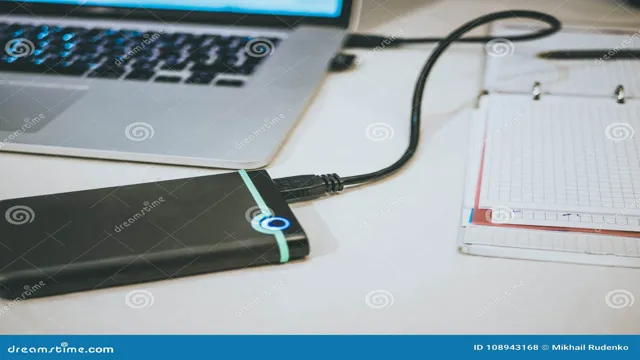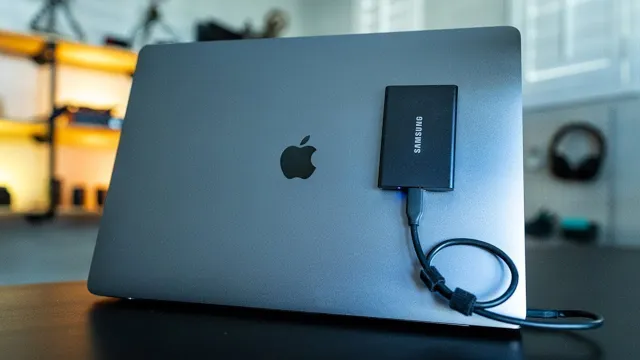If you’re a laptop user, you may wonder how SSD is connected to laptops. SSD stands for solid-state drive, a form of data storage that is becoming increasingly popular. In this blog post, we will explore how SSD is connected to laptops and the benefits of using SSDs.
Whether you’re a tech expert or a casual user, this article will provide valuable insights. So, sit back, relax, and let’s dive deep into the world of SSDs!
Internal SSD Connection
When it comes to internal SSD connection, most laptops use a standard interface called SATA (Serial Advanced Technology Attachment). This port connects the SSD drive to the motherboard and allows for easy data transfer. However, newer laptops are starting to use a faster interface called NVMe (Non-Volatile Memory Express), which uses the PCIe (Peripheral Component Interconnect Express) slot to provide even faster data transfer speeds.
NVMe SSDs are becoming increasingly popular due to their lightning-fast read and write speeds, making them perfect for gaming or heavy data usage. Regardless of the type of connection, upgrading your laptop’s internal drive to an SSD is an excellent way to improve performance and decrease boot times. So, if you’re looking to increase your laptop’s speed, consider upgrading to a newer SSD that uses the faster NVMe connection.
SATA Connection vs NVMe Connection
Internal SSD Connection When it comes to internal SSD connections, two options are SATA and NVMe. SATA is the traditional connection, while NVMe is a newer and faster option. SATA connections are often used in older systems, and it has a speed limit of around 550 MB/s.
On the other hand, NVMe connections can reach up to 3,500 MB/s, making it significantly faster. SATA connections use a cable to connect to the motherboard, while NVMe connections are installed directly into the motherboard. NVMe connections utilize PCIe lanes, which allows for faster data transfer rates.
While SATA connections are sufficient for basic tasks, NVMe connections are ideal for high-demanding tasks such as video editing or gaming. In summary, the decision between SATA and NVMe connections depends on the user’s needs, but NVMe is the faster and more modern option.

SATA Connection
SATA Connection When it comes to connecting an internal SSD to your computer, one of the most common options is the SATA connection. SATA stands for Serial Advanced Technology Attachment and is a type of data transfer technology that’s been around for quite some time. It is a popular choice for connecting storage devices because it is fast, reliable, and inexpensive.
SATA connections are typically used for connecting hard drives and SSDs to desktop computers, laptops, and servers. One of the main benefits of SATA is its ease of use. The cables and connectors are simple to plug in and remove, making it easy to upgrade or replace storage devices.
Another benefit of SATA is its speed. SATA can transfer data at speeds of up to 6 Gbps, which is more than enough for most applications. Another advantage of SATA is its compatibility.
It has been around for years, which means that it is compatible with almost all modern computer systems. This makes it easy to find a SATA-compatible SSD that will work with your computer. In conclusion, the SATA connection is a popular choice for connecting internal SSDs to computers because it is fast, reliable, and easy to use.
If you’re in the market for an SSD upgrade, be sure to look for one with a SATA connection to ensure compatibility with your system.
NVMe Connection
When it comes to internal SSD connections, NVMe is a game-changer. NVMe, which stands for Non-Volatile Memory Express, offers lightning-fast data transfer speeds compared to previous technologies. It allows for data to be transferred directly between the processor and the storage device, bypassing the traditional input/output (I/O) controller.
This means that data can be accessed and loaded much more quickly, making NVMe drives a top choice for those who need high-performance storage solutions. NVMe connections typically utilize the PCI Express interface, which provides high bandwidth and low-latency connectivity. With the increasing demand for faster and more efficient storage, it’s easy to see why NVMe drives are gaining popularity in both consumer and enterprise markets.
So, if you’re looking for a storage solution that offers unbeatable speed, NVMe is the way to go.
External SSD Connection
“How is the SSD Connected to the Laptop?” When it comes to an external SSD connection, there are a few ways to make this happen. Some SSDs connect to the computer via USB, while others may use Thunderbolt or some other interface. In general, connecting an external SSD to a laptop or computer is a relatively straightforward process that many people find to be quite simple.
Depending on the type of SSD you have, you may need to use a specific cable or adapter to make the connection, but most models will come with the required components. Once you’ve made the connection, you should be able to access the SSD just like you would any internal hard drive. So, whether you’re using your external SSD for backup, file storage, or some other purpose, you can enjoy fast access to your data with just a few simple steps.
USB Connection
When it comes to connecting an external SSD to your device, using a USB connection can be a simple and effective solution. Not only is USB widely available on most devices, but it also provides a fast and reliable connection with high data transfer rates. However, it’s important to make sure that your device supports USB
0 or above to fully take advantage of the SSD’s capabilities. Additionally, it’s crucial to use a reliable and high-quality USB cable to ensure stable connectivity and prevent data loss or corruption. Overall, utilizing a USB connection is an easy and efficient way to connect an external SSD to your device, allowing you to transfer and store data quickly and securely.
Thunderbolt Connection
Thunderbolt connection is a highly effective way of connecting an external SSD to your computer. It provides faster data transfer speeds compared to USB, making it an ideal choice for users who work with large files such as video editing or gaming. Thunderbolt connection is also bi-directional, which means that it can transfer data and video signals simultaneously.
This feature enables users to connect their computer to an external monitor, allowing them to work on a larger screen. External SSDs are an excellent option for people who want to store large amounts of data, especially for people on the go. Thunderbolt connection makes it possible to transfer files quickly and easily, increasing productivity and reducing wait times.
With Thunderbolt connection, users can access their data in a matter of seconds, making their work seamless and efficient. So, if you’re looking for a reliable connection for your external SSD, Thunderbolt is certainly the way to go.
Conclusion
In conclusion, the SSD (Solid State Drive) is connected to the laptop through a magical combination of electrical signals and hardware wizardry. Essentially, it’s like two long lost lovers finding each other in a sea of cables and ports, with a lightning bolt of speed and efficiency igniting their connection. It’s a beautiful thing, really.
So next time you’re admiring the lightning-fast performance of your laptop, remember that it’s all thanks to the magic of SSD technology. Or maybe it’s just really advanced science. Either way, it’s pretty cool.
“
FAQs
What are the types of interfaces used to connect an SSD to a laptop?
There are three types of interfaces used to connect an SSD to a laptop: SATA, M.2, and PCIe.
Is it possible to connect an SSD to a laptop externally?
Yes, you can connect an SSD to a laptop externally using a USB adapter or an external enclosure.
What is the maximum transfer rate for an SSD connected to a laptop?
The maximum transfer rate for an SSD connected to a laptop varies based on the interface used, but it can range from 6 Gbps (SATA) to 32 Gbps (PCIe 4.0).
Can I connect multiple SSDs to a laptop?
Yes, you can connect multiple SSDs to a laptop if the laptop has multiple interfaces or expansion slots. Some laptops also support RAID configurations for multiple SSDs.
